History of Hanfu Attire
The history of Hanfu attire is a fascinating journey through the centuries, reflecting China’s rich cultural heritage and sartorial traditions. This section delves into the origins and evolution of the Hanfu jacket, highlighting key milestones and regional variations.
Origins of Hanfu
The roots of Hanfu attire date back over 3,000 years to the Shang Dynasty (c. 1600–1046 BCE). Initially, it consisted of simple garments made from woven silk or hemp. These early prototypes laid the foundation for the elegant Hanfu jackets we see today.
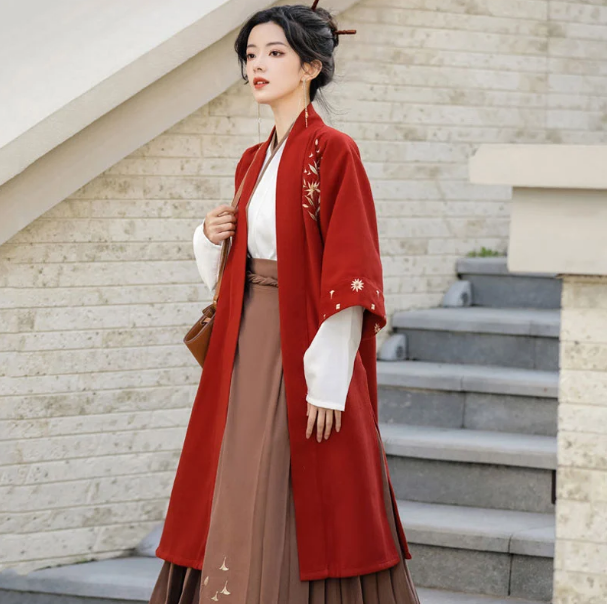
Evolution through Dynasties
Zhou Dynasty (c. 1046–256 BCE): During this period, Hanfu attire became more structured and layered, with distinct styles for men and women. The addition of sashes and belts added to its sophistication.
Han Dynasty (c. 206 BCE–220 CE): The Hanfu jacket, known as the “Yi,” gained prominence. It featured crossed collars and wide sleeves, setting the standard for later designs.
Tang Dynasty (618–907 CE): The Tang Dynasty marked a golden era for Hanfu fashion. Jackets became more elaborate, often adorned with intricate embroidery and colorful patterns.
Ming Dynasty (1368–1644 CE): Hanfu jackets evolved into a fusion of classic styles and new innovations. Loose-fitting designs and vibrant colors characterized them.
Components of a Hanfu Yi
A traditional Hanfu jacket, known as the “Yi,” consists of several key elements that contribute to its unique and timeless design.
Collar and Neckline
The collar of a Hanfu Yi is characteristically straight and upright. It elegantly frames the wearer’s face with a typically V-shaped or squared neckline, adding a touch of sophistication.
Sleeves and Cuffs
Hanfu sleeves are wide and flowing, allowing for freedom of movement. The cuffs, enhancing the overall aesthetic, may vary in width and feature decorative embroidery or trim.
Fastenings and Ties
Traditional Hanfu jackets do not have buttons or zippers. Instead, they are fastened using ties or fabric knots. These ties can be located at the chest or along the side, providing a secure yet graceful closure.
Length and Fit
The length of a Hanfu Yi can vary, with options ranging from hip-length to ankle-length. The fit is typically loose and comfortable, allowing for ease of movement. This design also reflects the emphasis on modesty in Chinese culture.
Fabrics and Materials
Hanfu jackets are traditionally made from silk, which is known for its luxurious texture and sheen. Silk adds to the overall aesthetic appeal and comfort of the garment. However, other materials, such as cotton or brocade, have also been used throughout history.
Embellishments and Embroidery
Elaborate embroidery is a hallmark of Hanfu attire. It can adorn the collar, sleeves, and cuffs, often featuring intricate patterns and symbols that hold cultural significance. The embroidery can vary in the level of detail and craftsmanship, and some pieces highly prize them for their artistry.
Colors and Patterns
Traditional Hanfu jackets come in a wide array of colors, with each shade carrying its own symbolic meaning. Common colors include red for joy, yellow for royalty, and blue for tranquility. Patterns such as dragons, phoenixes, and auspicious symbols are often incorporated into the fabric design.
Maintenance and Care
Due to the delicate nature of silk and intricate embroidery, Hanfu Yi requires special care. Gentle hand washing and air drying are recommended to preserve the quality and lifespan of the garment.
Explore more about the components of a Hanfu Yi on Wikipedia.
Regional Variations of Hanfu Jackets
The diverse cultures and climates across China have led to various styles and names of Hanfu jackets, reflecting the unique characteristics of each region.
Northern Variations
Styles: In northern China, Hanfu jackets are often known as “Mianfu” due to their quilted construction. These jackets are designed to provide warmth during cold winters.
Materials: “Mianfu” jackets are typically made from thick, padded materials, with layers of cotton or silk to insulate against the harsh northern winters.
Colors: Common colors for northern Hanfu jackets include deep blues, blacks, and dark reds, reflecting the colder climate and the practical need for warmth.
Southern Variations
Styles: In the south, “Shenyi” is a popular style of Hanfu jacket. It is lightweight and suitable for the hot and humid climate of the region.
Materials: “Shenyi” jackets are made from breathable fabrics like silk or lightweight cotton, ensuring comfort in the sultry southern weather.
Colors: Southern Hanfu jackets often feature lighter and brighter colors such as pastel pinks, greens, and whites, reflecting the warmer and sunnier climate.
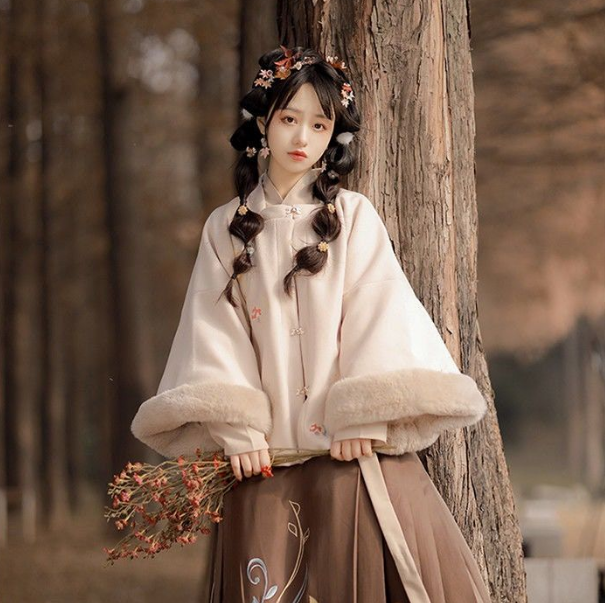
Western and Central Variations
Styles: In the western and central regions of China, Hanfu jackets may take on unique regional names like “Dahua,” “Lifusheng,” or “Xibei” jackets. These styles may feature distinctive cuts and embellishments.
Materials: The choice of materials for these regional variations can vary widely, depending on local preferences and availability.
Colors: Colors used in these regions can be influenced by cultural traditions and historical significance.
Eastern Variations
Styles: Eastern China, with its rich cultural heritage, has its own set of Hanfu jacket styles. The “Xiapei” jacket is one such example, known for its elegant and flowing design.
Materials: “Xiapei” jackets are typically crafted from high-quality silk, reflecting the region’s historical prosperity and sophistication.
Colors: Eastern Hanfu jackets often showcase a wide range of colors, including soft pastels and intricate patterns, symbolizing the region’s artistic traditions.
Unique Regional Embellishments
Each regional variation of Hanfu jacket may feature unique embellishments, embroidery patterns, and decorative elements that reflect local customs and traditions.
For more information on the regional variations of Hanfu jackets, refer to Wikipedia.
Cultural Significance of the Hanfu Jacket
The Hanfu jacket carries deep cultural and symbolic meanings, reflecting the essence of Chinese heritage and values.
Rooted in Tradition
Heritage Preservation: The Hanfu jacket symbolizes the preservation of Chinese cultural heritage, emphasizing the importance of tradition and continuity.
Modesty and Respect: It embodies Confucian ideals of modesty, respect for ancestors, and reverence for the past.
Symbolism in Design
Crossed Collars: The crossed collars signify the harmonious connection between heaven and earth, aligning with Chinese cosmology.
Wide Sleeves: Wide sleeves represent open-mindedness, flexibility, and adaptability, virtues highly regarded in Chinese culture.
Colors and Symbolic Meanings
Red: Symbolizes joy, happiness, and good fortune.
Yellow: Represents royalty, power, and prosperity.
Blue: Signifies tranquility, serenity, and stability.
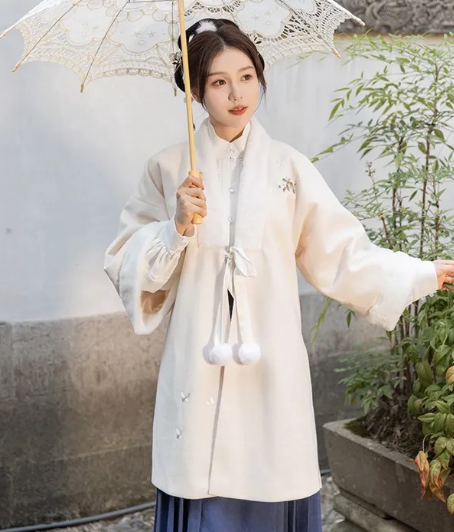
Occasions and Rituals
Weddings: Hanfu jackets are commonly worn by brides and grooms in traditional Chinese weddings, symbolizing the union of two families and the start of a harmonious life together.
Festivals: During festivals like the Spring Festival (Chinese New Year), wearing Hanfu jackets showcases cultural pride and reverence for ancestors.
Modern Resurgence
Cultural Revival: The resurgence of Hanfu fashion in modern times reflects a desire to reconnect with cultural roots and preserve traditions in a rapidly changing world.
Fashion Statements: People are increasingly wearing Hanfu jackets not only for cultural events but also as fashion statements, blending tradition with contemporary style.
National Identity
Cultural Heritage: The Hanfu jacket is a symbol of Chinese cultural identity, fostering a sense of belonging and pride among the Chinese people.
Global Recognition: Internationally, it serves as a recognizable representation of Chinese culture, promoting cross-cultural understanding.
For more detailed information on the cultural significance of the Hanfu jacket, visit Wikipedia.
Modern Hanfu Revival
The resurgence of Hanfu fashion in contemporary Chinese culture is a testament to the enduring appeal of this traditional attire.
Cultural Renaissance
Cultural Pride: The revival of Hanfu reflects a renewed sense of cultural pride and identity among the Chinese youth, who are eager to reconnect with their heritage.
Preservation of Tradition: It serves as a means of preserving and reviving traditional Chinese clothing and customs that had faded over time.
Fashion Trend
Fashion Statements: Hanfu has transcended its traditional roots to become a prominent fashion trend in China. It is worn not only during cultural events but also as everyday attire.
Blend of Tradition and Modernity: Designers and enthusiasts are creating modern interpretations of Hanfu, combining traditional elements with contemporary styles, appealing to a wider audience.
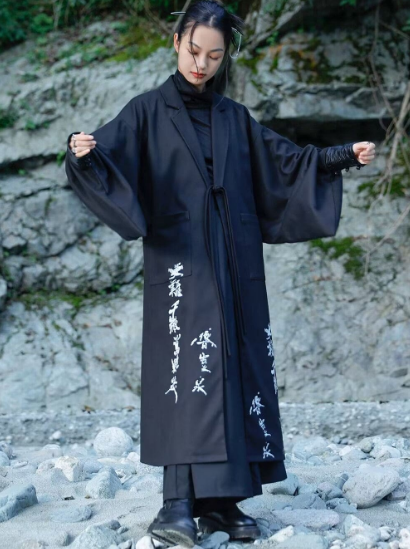
Revival in Media and Pop Culture
Television and Films: Hanfu has gained prominence in Chinese television dramas and movies, sparking interest and admiration among viewers.
Social Media Influence: Platforms like Weibo and TikTok have played a significant role in popularizing Hanfu fashion. Influencers showcase various styles and accessories, attracting millions of followers.
Economic Impact
Market Growth: The Hanfu industry has witnessed substantial growth, with the market size estimated at over 1 billion yuan (approximately 156 million USD) in recent years.
Entrepreneurship: Many entrepreneurs have capitalized on the Hanfu trend, establishing brands, boutiques, and online stores dedicated to Hanfu clothing.
Educational Initiatives
Hanfu Education: Educational institutions are introducing courses on Hanfu history and design, promoting a deeper understanding of its cultural significance.
Cultural Festivals: Hanfu festivals and events have become increasingly popular, attracting participants and enthusiasts from all over China and even internationally.
Global Impact
Cross-Cultural Exchange: The resurgence of Hanfu has facilitated cross-cultural exchanges, as people from different parts of the world explore and appreciate Chinese traditions.
Tourism and Cultural Diplomacy: Hanfu has become a part of China’s cultural diplomacy efforts, attracting tourists and fostering cultural exchange.
For a comprehensive overview of the Modern Hanfu Revival, visit Wikipedia.
Styling and Accessories for Hanfu Jackets
Wearing a Hanfu jacket is an art in itself, and the right accessories can elevate the overall look. Here are some tips on how to style a Hanfu jacket and the accessories that complement this attire.
Choosing the Right Hanfu Jacket
Fit and Length: Ensure that your Hanfu jacket fits comfortably and complements your body shape. The length can vary, but it should generally match the occasion and your preference.
Fabric and Color: Select a fabric and color that suits the season and event. Silk is a popular choice, but cotton or brocade options are also available. Color should harmonize with the overall Hanfu ensemble.
Layering
Inner Garments: Underneath the Hanfu jacket, wear appropriate inner garments like a traditional “Ruqun” or “Shenyi” that match the style and occasion.
Belt and Sash: Secure the jacket with a matching belt or sash. Ensure it’s tied neatly to maintain the elegant appearance.
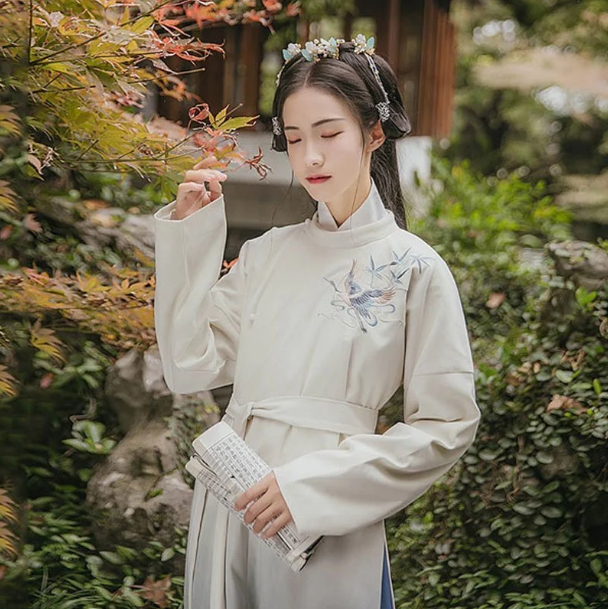
Accessories
Hair Accessories: Complement your hairstyle with traditional hairpins, combs, and ornaments like “Huadian.” These accessories add grace to your overall look.
Jewelry: Delicate jewelry pieces like earrings, necklaces, and bracelets can enhance the elegance of your Hanfu outfit. Opt for designs that match the jacket’s style and color.
Footwear
Traditional Shoes: Pair your Hanfu jacket with traditional Chinese shoes like “Ruqun” shoes or embroidered slippers. Ensure they are comfortable for walking.
Makeup and Hairstyling
Natural Makeup: Keep makeup simple and natural to maintain a classic and modest appearance.
Hairstyle: Style your hair in a way that complements the jacket. Traditional Chinese hairstyles or simple updos work well.
Occasion-Specific Styling
Weddings: For wedding attire, consider more elaborate accessories like a bridal crown or headdress.
Festivals: During festivals, incorporate festive accessories like tassels or auspicious symbols.
Formal Events: When attending formal events, choose elegant and refined accessories that match the occasion’s tone.
Maintenance and Care
Cleaning: Follow care instructions for the specific fabric of your Hanfu jacket. Some may require dry cleaning, while others can be hand-washed.
Storage: Store your Hanfu jacket carefully in a cool, dry place to prevent damage and maintain its quality.
By paying attention to these styling tips and carefully selecting the right accessories, you can create a stunning and culturally rich look when wearing a Hanfu jacket.
For more information on Hanfu styling and accessories, refer to Wikipedia.







